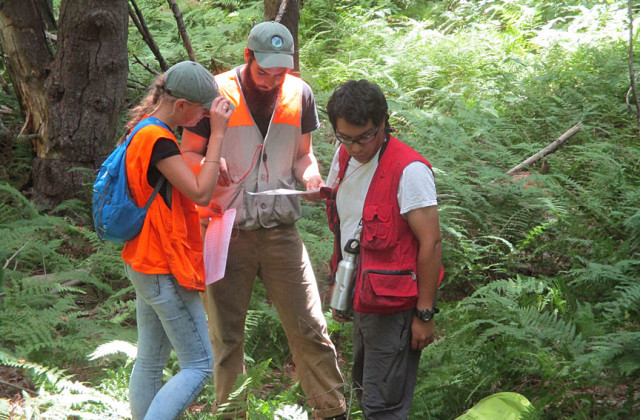Summer Interns at Great Mountain Forest
Planning for the future
By Hans M. Carlson
Outside of the Great Mountain Forest (GMF) administrative offices, this summer’s interns are building a small raised-bed garden after work. It’s a bit late in the season, but even if they don’t get much of a yield this year, the bed will be ready for next spring. They are working as much to create an opportunity for next year’s crew as they are to grow vegetables for themselves. With any luck this will be an ongoing thing here on the mountain—something to enjoy and utilize in years to come.
Across the street, our interns are working on an even longer term project, though one in a similar vein. The acreage over there is old regrown pasture for the most part, and isn’t much to look at presently. White pine seeded in, as it did in so many old fields, but most of it was damaged by weevils when it was young. Even more so than the trees on the old Norfolk Downs, weevils left these pines with wavy boles and scraggly branches that make them look like something out of a Dr. Seuss book. The understory also has a significant amount of Japanese Barberry, a problematic invasive. All this presents a challenge for managing this part of the forest.
One thing the area does have is vigorous young sugar maples in the understory—what foresters refer to as advanced regeneration. Sugar maple is shade tolerant, and these trees seeded in under the pines, likely from the large old trees that we tap along Canaan Mountain Road. Getting them to grow into productive trees seemed an obvious goal, but this will take thought and planning to be successful.
Earlier this spring, Forest Manager Jody Bronson gave this year’s interns the task of creating and carrying out a management plan for a few acres in this area. A management plan for something this size is essentially a road map for a single project. It delineates what they feel they have to work with, and describes the desired end result. The stewardship plan that Bronson writes every ten years for GMF is a management plan too, but one that defines larger goals. It’s strategic rather than tactical—a master plan within which other smaller projects can be fit into.
Earlier this summer, the barberry in the area was treated with herbicide. The use of chemicals was necessary, given how established the invasive had become. Without control in a situation like this, the disturbance caused by working in the area would have given the barberry the opportunity to spread even further.
The next step in the process, and the one that is ongoing now, is to establish the boundaries of the managed area and to inventory the species and number of trees. Then it will be a matter of marking those trees to be taken and those to be left. Because the young maples have grown in the shade, they cannot withstand a sudden flood of heat and light, so the thinning will have to be done gradually and carefully. Much of the pine will go, but it will have to be done in stages over the course of several years.
Ideally, there would be a use for any wood taken out during the thinning, like the Norway spruce that were thinned this last winter along the Chattleton Road, that will be used for a new cabin. In the case of these damaged pines however, there is little use. With a larger, managed area they might be chipped for mulch or biomass, but it would not be economical to bring in trucking for so few trees. These pines will be left to put nutrients back in the soil, potentially stacked to create brush for animal habitat.
In a private management plan, this might be all that happened, but on this project there will be an educational component as well. The interns are working on several ideas, including demonstrations of various tapping methods in this young sugarbush—taps and bucket, and tube line. There may be interpretive signs to explain in more detail than what I’m sketching here, but these decisions will be theirs.
This year’s group will start the process, but it will be an ongoing project as years go by. It will eventually take in more acreage and different management techniques over time, just as there may be more raised beds out behind the offices in years to come.
Photo by Hans Carlson.

